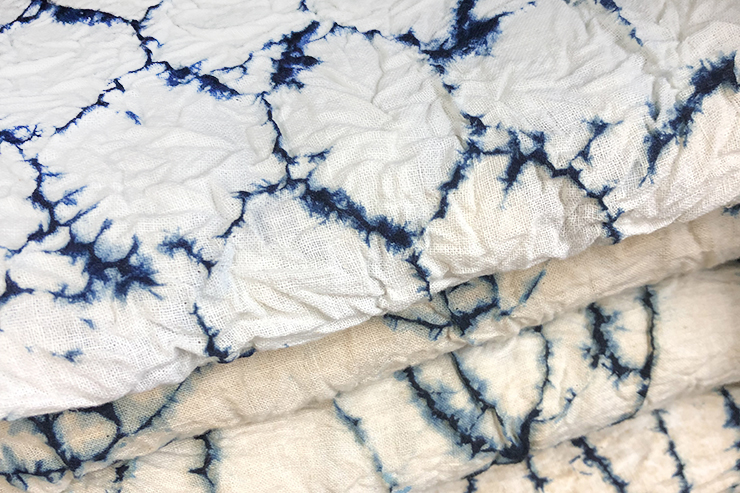
People make choices on what to wear on daily basis. Outfits are the outermost shell for a person, and they envelope us like borderline between our world and the world outside. Outfits are usually made from textile. People put on the textile and dressed themselves to connect with the world outside.
Though there is no evidence as to when exactly humans started putting on clothes, but it is probably a fair guess to say the earliest type of outfits may have had been something like fur that protected them from the outside world. When the sense of shame began to grow in the naked life, whenever that may be, textiles became as essential as “food” for their lives. Textile allowed the display of beauty, and acted as a means to exhibit status or position in some occasions. Wearing textile was a means to express the self to the world outside, just as a part of their thoughts or minds.
The primitive textiles were woven with the yarn spun from plants growing in the surrounding environment. As in the example of some vegetables indigenous to the thermal areas of Central and South America that contain the effect of cooling down the body of their consumers, a plant of a certain locality would turn into a textile that has characteristic deeply rooted in the local climate; plants from hot land would bring coolness, and cold land plants warmth. Moreover, another plant of the locality would be used to dye the yarn, while the locally worshipped patterns would be woven in to decorate the textile.

The term kofu, or the “old textile” refers to the textiles woven before the WWII. Back then, people wore kimono as their daily outfits, lived in the traditional Japanese housing and practiced the seasonal Shinto ritual. After the war, such traditional life style started to disappear. Textiles with a variety of characteristic had been produced in all over Japan, based on geological factors such as production places of silkworms and cotton plants or the distance from the capital, in addition to historical factors. Each of such textiles has the name of the production locations in their names, such as, Edo Komon, Ueda Tsumugi, Tango Chirimen or Kaga Yuzen. Each of them exhibits examples of Japanese textile techniques of dyeing and pattern design such as stamp dyeing or tie-dyeing.

The uses of textiles depended on and varied by the material. Silk textile was used for the outfit of high-class men, cotton textile for housemaids, and hemp for work clothes. Moreover, people used textiles to pack and carry goods, stretched to make housing, and wrapped it around themselves to sleep. Textile freely changed its shape to fit for various purposes in daily life. All of them were hand-sawn, and when no longer in use, they would be un-sawn and sawn back into something different and needed. If they get holes, they would be repaired and patched, and a piece of textile would be used until they literally turn into dust. Considering all of the endless work required for weaving a piece, textile was precious enough for people to put so much effort in maintaining.
In the Tohoku (North-Eastern area) of Japan where the climate is severe, people quilted textiles in order to keep off the cold or to reinforce shoulders or back parts that get worn off from carrying heavy loads during farm works. These quilted textiles are known as sashiko, and they were not just a simple quilt. Patterns are incorporated, often as a talisman, and each stitch was sawn with prayer. On the piece that has been handed down for generations, traces of every effort made for survival are evident. Such pieces of textiles are called BORO, and are highly valued among collectors of textile and contemporary arts worldwide.
The majority of BORO is dyed with indigo. The technique of indigo dyeing was brought into Japan from China. With its antimicrobial and deodorant functions as well as high insect proofing effect that improves preservability, various textile goods have been dyed with indigo since its introduction. The title of “Japan Blue”was originally given by a British scientist who witnessed the beautiful indigo-dyed textile that overfilled the town he visited. It has now become a universal term. The Japanese language has a wide variety of vocabulary to describe the color of blue. The color of indigo slowly fades in the changing light of four seasons. Watching the color fading could have had been a way for the people to appreciate the passing of time. Deep inside a piece of the textile lies the true beauty of the color, which can only be revealed by passage of time.

Textiles have occasionally existed as outfits, household tools, offering for the deity or as family treasure. Textiles have stories to tell. Stories about the landscapes of the places it had been. Stories of the people, woven in between warps and wefts. Textiles exist as the playback system for those stories beyond time and place.
- Textile :
- Aizu Momen
- Textile of Okinawa
- Ryukyu Bingata
- Ryukyu Kasuri
- Yuki Tsumugi
- Old textile
- Dyeing :
- Indigo

